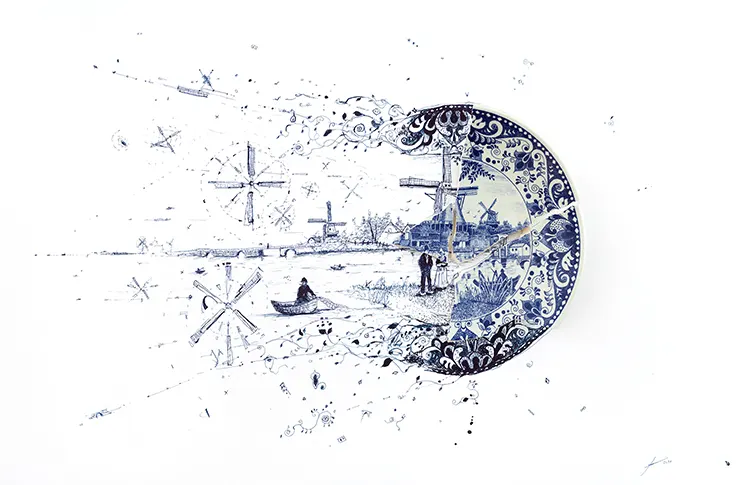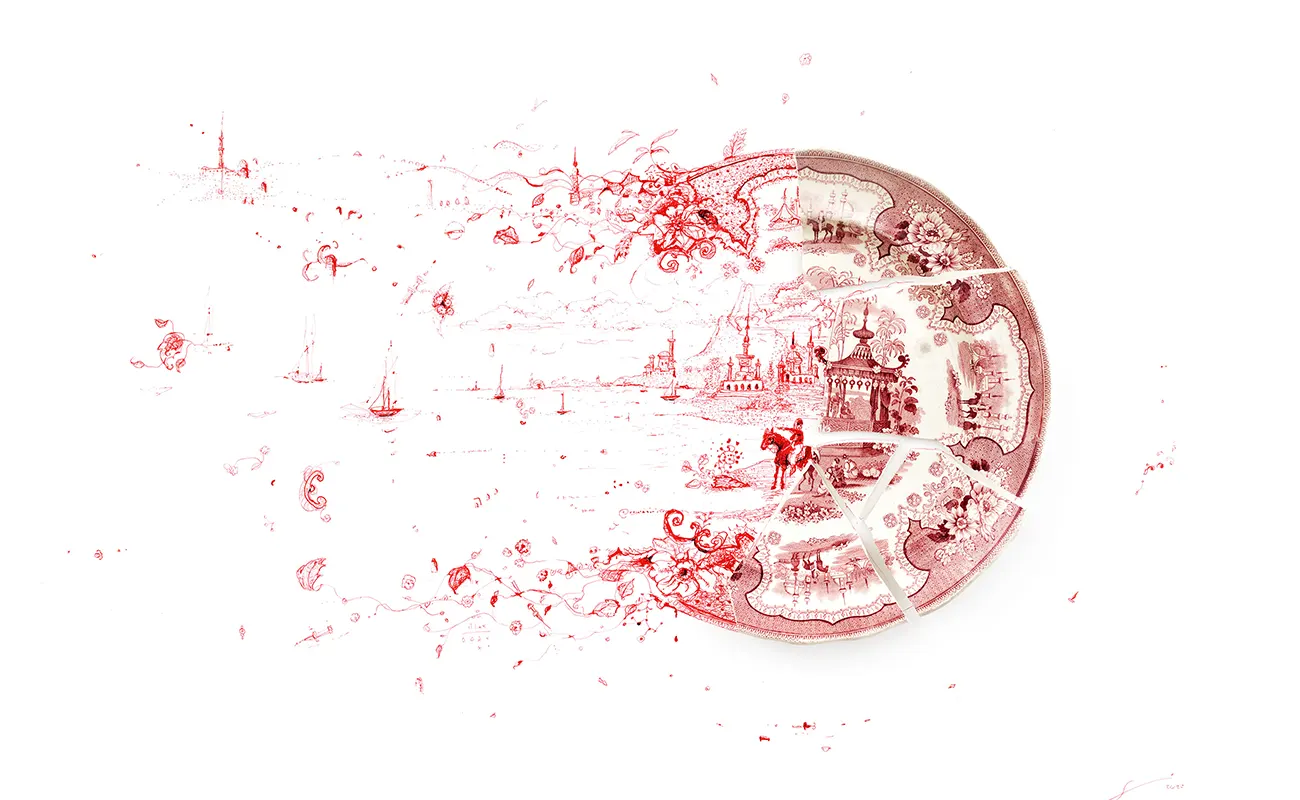“I think the difference with this work is that it originated as a gift of love for my wife, Jocelyn, and mother-in-law, Barbara. I believe that this is why it is resonating with so many people.”
The Genesis of a Unique Artistic Vision
Rob Strati, an artist with a rich tapestry of experiences in art, art history, technology, and AI, has been a visible figure in the contemporary art world for three decades. His journey began in the bustling artistic landscape around Ohio State University, where his creative pursuits took root. Strati’s early works graced galleries and museums from the Wexner Center in Ohio to Catharine Clark Gallery in San Francisco, Sherry Frumkin in Los Angeles, and Robert Henry Gallery in New York. These exhibitions, spanning various geographical and cultural contexts, laid the groundwork for his distinctive approach to art.
The artist’s current project, “Fragmented,” emerged from a poignant domestic incident during the pandemic – the accidental shattering of a plate inherited from his wife’s mother. This event, while seemingly trivial, ignited Strati’s imagination, leading to a profound exploration of the narratives and possibilities hidden within broken fragments. This project not only marks a new phase in Strati’s career but also reflects a personal dimension, as it began as a loving tribute to his wife, Jocelyn, and mother-in-law, Barbara. It’s this fusion of personal and artistic exploration that Strati believes resonates deeply with his audience.
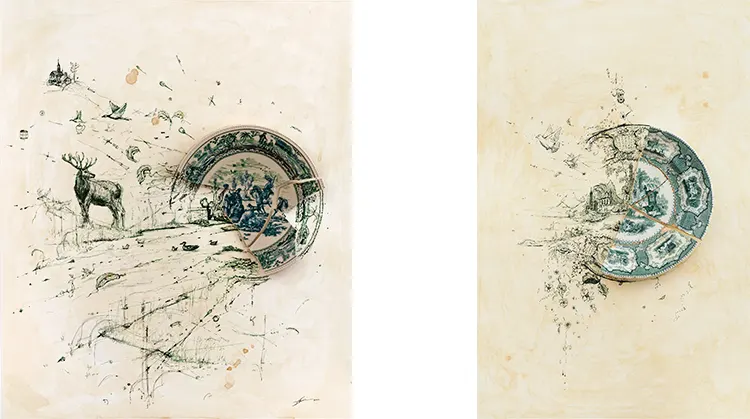
Rob Strati: A Lifelong Engagement with Art
From an early age, Strati was destined for the artistic path. Encouraged by his parents and recognized for his talent in school, he consistently engaged with art, an activity that not only defined his childhood but also shaped his future. His time at Ohio State University was pivotal, though he found the structured environment of art school constraining. This desire for creative freedom led him to adopt an unconventional approach to his studies and, by extension, to his career in the art world. Strati’s journey has been one of constant engagement with the art system, yet always on his own terms, reflecting a unique blend of conformity and rebellion.
Strati’s artistic style, especially in his recent works, defies easy categorization. It’s an eclectic mix that intertwines traditional drawing, mixed media, contemporary sensibilities, and expressionism. The themes he explores are just as diverse, yet they converge on a central narrative: the process of fragmentation and reconstruction. Strati delves into the emotional journey from sadness and loss to acceptance and creative action. His approach goes beyond mere repair or disposal; it’s about reimagining and giving new life to what was broken. This philosophical and emotional exploration through art is what sets Strati’s work apart, adding layers of depth and meaning to each piece.
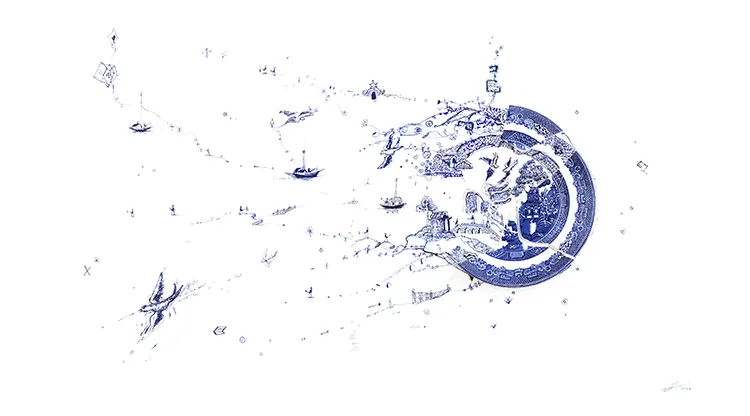
In the Artist’s Sanctuary
Rob Strati’s creative process is an intimate dance with chaos and control, set in a workspace that is as unique as his art. This space, a crucible of creativity, is equipped with seemingly mundane yet essential items: pens, plates, paper, a work table, and intriguingly, a rock in a box. This last item plays a crucial role in his art-making process. By dropping plates with the help of the rock, Strati orchestrates a controlled chaos, ensuring each break is unique yet manageable. The process starts at his work table, where he arranges the fragmented pieces, often resorting to a chair for an elevated perspective, envisioning how they would appear on a wall.
Once the initial arrangement is set, Strati’s process becomes more fluid and spontaneous. He frequently shifts his creations to the floor, a transition that signifies a new phase of development. This movement from table to floor is not just physical but also a metaphor for the artist’s journey through the layers of his work. Strati’s approach to distractions is equally unconventional. Rather than resist them, he embraces these interruptions, incorporating the rhythms of daily life into his art. This philosophy allows life itself to become a co-creator in his art, making each piece a unique reflection of a moment in time.
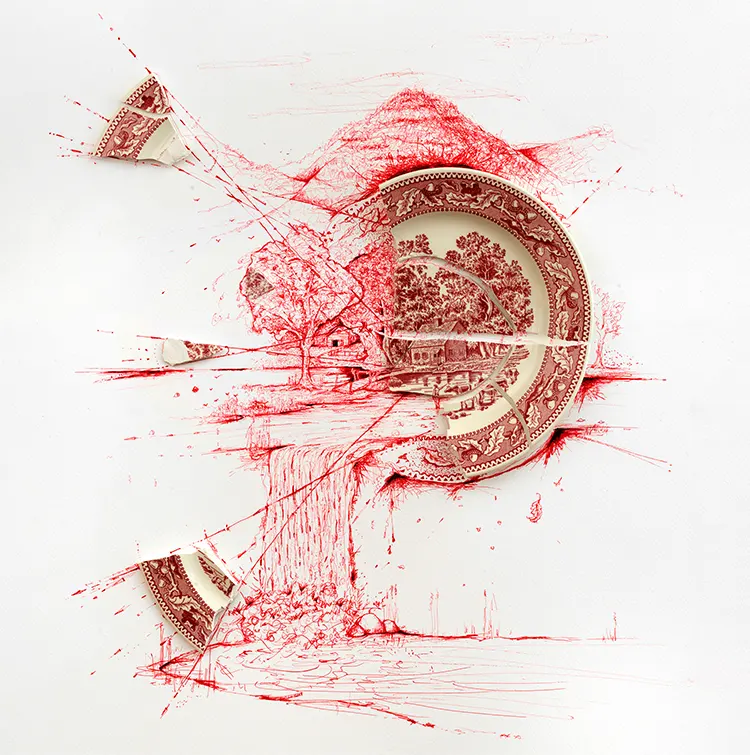
Rob Strati: Influences and Inspirations
The artistic influences on Rob Strati are as varied as the fragments he pieces together in his work. He draws inspiration from a wide array of sources, ranging from the abstract expressionism of Cy Twombly to the precise sketches of Albrecht Dürer, the geometric forms of Kazimir Malevich, the collage-like techniques of Kurt Schwitters, and the iconic works of Leonardo da Vinci. Strati also finds inspiration in the meticulous work of archaeologists and conservators in museum restoration departments, whose task it is to piece together history from remnants. This eclectic mix of influences speaks to the layered complexity of Strati’s work, where each piece is a confluence of different artistic traditions and styles.
A specific artwork that holds special significance for Strati is Marcel Duchamp’s “The Large Glass,” housed in the Philadelphia Museum. His encounter with this piece at the age of 18 was transformative, marking a pivotal moment in his artistic development. The mechanical yet ethereal nature of the artwork, coupled with its imperfections—like the cracks formed during transport which Duchamp embraced as part of the work—resonated deeply with Strati. This encounter highlights a key aspect of his artistic philosophy: the beauty and potential of imperfection and the process of creation itself.
Strati’s choice of mediums further reflects his fascination with the everyday and the ordinary. He is drawn to materials like packing tape, baling wire, and rubber bands, finding beauty and potential in their simplicity. His latest venture incorporates a common kitchen object, a plate, symbolizing both the utilitarian and the aesthetic, and resonating with Strati’s inclination towards materials that are commonplace yet capable of extraordinary transformation.
Envisioning future projects, Strati is currently conceptualizing a unique china cabinet piece, a project that promises to blend diverse stories and cultures through the medium of broken plates. This idea, still in its nascent stage, signifies Strati’s ongoing journey of exploring fragmentation and reconstruction, not just as an artistic process but as a narrative that weaves together different cultural and personal histories. The artist’s work continues to evolve, a testament to his enduring creativity and his ability to see the extraordinary in the ordinary.
